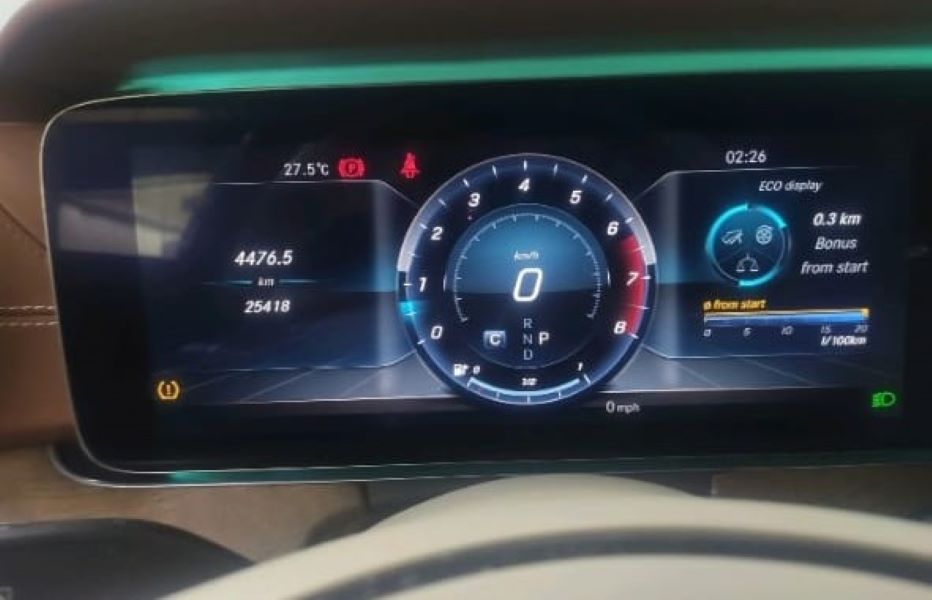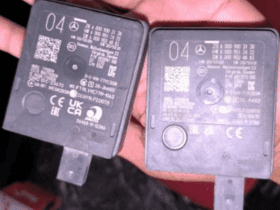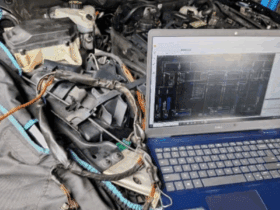Table of Contents
Case Study: Diagnosing and Fixing “Tyre Pressure Low” in a Mercedes-Benz E-Class W213
Modern Mercedes-Benz models rely on an intelligent Tire Pressure Monitoring System (TPMS) to enhance driving safety and efficiency. But what happens when the “Tyre Pressure Low” warning stays on even after inflating the tyres correctly?
This case study explores a real-world diagnostic and repair process for a Mercedes-Benz E-Class W213, where a persistent tyre pressure warning led to the discovery of two defective TPMS sensors.
For more diagnostic repair stories and maintenance tips, visit our comprehensive hub:
Mercedes Maintenance and Service Guide Hub
Customer Complaint: Tyre Pressure Low Warning Won’t Clear
A customer brought their Mercedes-Benz E-Class W213 to the workshop, reporting that the Tyre Pressure Low message appeared repeatedly on the dashboard, despite inflating all tyres to the correct pressure.
The goal: determine whether the fault was mechanical (air leak or puncture) or electronic (TPMS malfunction).

Step 1: Initial Visual and Manual Inspection
The technician began with a standard physical inspection:
- – Checked tyre pressure with a calibrated gauge all four tyres were inflated correctly.
- – Verified there were no visible leaks, punctures, or bead damage.
- – Yet, the warning remained active, pointing toward a sensor communication issue.
Since basic checks didn’t reveal the fault, an advanced diagnostic test was initiated.
Step 2: Short Test via Mercedes-Benz XENTRY Diagnostic Tool
Using the Mercedes-Benz XENTRY Diagnosis System, the technician ran a short test to identify TPMS-related error codes.
Results showed communication errors from both front tyre pressure sensors indicating either sensor failure or disrupted signal transmission.
Step 3: Checking Actual Values for Live Data Verification
Through XENTRY’s Actual Values function, the technician reviewed live tyre data (pressure, temperature, and battery status).
- – Front Left Sensor : No signal.
- – Front Right Sensor : No signal.
- – Rear Sensors : Fully operational.
This confirmed that the front sensors were unresponsive, while the TPMS control unit was functioning correctly.

Step 4: Testing with TPMS Tool for Confirmation
To validate the diagnosis, a Mercedes-Benz Tire Pressure Monitoring System Tool was used to activate each sensor individually.
- – Left Front Sensor : No response
- – Right Front Sensor : No response
- – Rear Sensors : Responding normally
Both front TPMS sensors had failed, likely due to depleted internal batteries.
Step 5: Replacing the Faulty TPMS Sensors
To fix the problem, both defective sensors were replaced with OEM Mercedes-Benz TPMS sensors to ensure system compatibility.
Replacement procedure:
- 1. Deflate and remove the affected tyres.
- 2. Remove faulty TPMS sensors from the rim.
- 3. Install new sensors and ensure proper alignment.
- 4. Reinflate the tyres to the manufacturer’s recommended PSI.
- 5. Reinstall the wheels and torque bolts to Mercedes-Benz specifications.


Step 6: Performing the TPMS Teach-In Process
After installation, the system required sensor recognition (Teach-In) to link the new sensors to the TPMS control unit.
Using the XENTRY diagnostic tool, the technician:
- 1. Accessed the TPMS control unit menu.
- 2. Selected “Teach-In New Sensors.”
- 3. Drove the vehicle above 25 km/h (15 mph) for approximately 10–15 minutes to initiate synchronization.
- 4. Verified that the Tyre Pressure Low warning disappeared from the cluster.
Result: The new sensors were successfully recognized, and all tyre pressures displayed accurately on the dashboard.


Step 7: Final Check and Test Drive
To confirm the repair:
- – A post-repair diagnostic scan showed no stored TPMS fault codes.
- – All four sensors transmitted stable and accurate readings.
- – A final test drive verified correct system behavior with no warnings or delays in pressure updates.
The Mercedes-Benz E-Class W213 was fully restored to factory performance, and the customer left with confidence in the vehicle’s safety systems.
Key Takeaways for Technicians and Owners
– Don’t ignore persistent tyre warnings. Even with correct pressure, faulty sensors can compromise safety monitoring.
– Always verify live TPMS data before replacing components.
– Use OEM sensors for proper compatibility and long-term reliability.
– Perform the Teach-In process after every sensor replacement to synchronize the system correctly.
– Check sensor age. Most TPMS sensors have a 5–7-year battery lifespan.
FAQs: Tyre Pressure Low Warning
Can You Drive on Low Tyre Pressure?
Driving on low tyre pressure is not recommended and can be extremely dangerous. Underinflated tyres reduce steering response, increase braking distance, and raise the risk of a tyre blowout especially at high speeds. Low pressure also causes uneven tread wear and increases fuel consumption due to higher rolling resistance.
If the “Tyre Pressure Low” warning appears, stop as soon as it’s safe, check all tyres with a reliable pressure gauge, and refill them to the manufacturer’s recommended PSI. If the warning persists even after inflation, it may indicate a faulty TPMS sensor that needs professional diagnosis.
What Do I Do If Tire Pressure Is Low?
If your tyre pressure is low, follow these steps to restore it safely:
- 1. Check all tyres using a calibrated pressure gauge when the tyres are cold.
- 2. Inflate to the correct PSI you can find this information in your owner’s manual or on the driver’s side door frame sticker.
- 3. Inspect for punctures or leaks, especially around the valve stem and tread area.
- 4. Reset or recalibrate the TPMS system if the warning light remains on after inflation.
- 5. Monitor tyre pressure regularly (at least once a month) to catch early pressure loss or faulty sensors.
If your tyres continue to lose pressure frequently, it could signal slow leaks, damaged rims, or a failing TPMS sensor have the system checked by a qualified technician.
Conclusion
This Mercedes-Benz E-Class W213 case study highlights how a simple Tyre Pressure Low warning can reveal deeper TPMS sensor faults. With proper diagnostics using XENTRY and the TPMS Tool, the issue was resolved efficiently through sensor replacement and reprogramming.
Understanding this process ensures that both technicians and car owners maintain accurate tyre pressure monitoring, better fuel economy, and optimal safety.
For additional repair insights and preventive maintenance tips, check out our in-depth resource hub:
Mercedes Maintenance and Service Guide Hub
Author Bio
Written by Mercedes Expert
With years of hands-on experience diagnosing and repairing Mercedes-Benz systems, he brings technical depth and practical case studies to help car owners, technicians, and enthusiasts troubleshoot complex automotive issues. His work focuses on clear repair guides, OEM-level procedures, and knowledge-sharing to empower both professionals and drivers.
Last update: November 2025






Leave a Reply